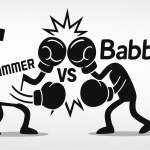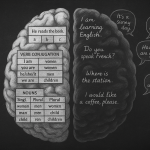Learning Norwegian can feel like a puzzle – between grammar, pronunciation, and vocabulary, you need a language learning app that helps you put all the pieces together quickly. But not all apps are built for speed. Some keep you entertained but move slowly, while others are designed to take you from your first “hei” to advanced fluency.
If you’ve searched for the best language learning app to learn Norwegian, you know the list is long: Duolingo, Busuu, Babbel, Anki, Memrise, Lingvist, LingQ, italki, Glossika, Quizlet – and Taalhammer. In this article, we’ll compare all of them to answer the question: which Norwegian learning app ensures the fastest progress?
- Taalhammer vs Duolingo: Serious Learning vs Habit Building
- Taalhammer vs Busuu: Adaptive Review vs Community Corrections
- Taalhammer vs Babbel: Which Norwegian Language Learning App Wins on Grammar and Context?
- Taalhammer vs Anki: Ready-Made Science vs DIY Flashcards
- Taalhammer vs Quizlet vs Memrise: Which Norwegian Vocabulary App Really Works?
- Taalhammer vs Lingvist: Fast Vocabulary Learning in Norwegian
- Taalhammer vs LingQ: Input-Only vs Balanced Learning
- Taalhammer vs italki: Tutors vs AI-Driven Self-Study
- Taalhammer vs Glossika: Smarter Sentences vs Repetition Drills
- Final Verdict: Why Taalhammer Is the Fastest Norwegian Language Learning App
- FAQs About Norwegian Language Learning Apps
- Which language learning app teaches Norwegian best for beginners?
- Is Duolingo good for learning Norwegian fast?
- What is the most effective Norwegian language learning app for serious learners?
- Which Norwegian language learning app prepares you best for exams?
- What is the fastest way to learn Norwegian with language learning apps?
Taalhammer vs Duolingo: Serious Learning vs Habit Building
Duolingo is often the first stop for learners. It’s free, gamified, and fun. You collect streaks, earn points, and feel like you’re making progress – but does that progress translate into fast Norwegian learning?
| Feature | Taalhammer | Duolingo |
|---|---|---|
| Focus | Sentences, grammar depth, CEFR A1–C2 | Gamification, bite-sized lessons |
| Speaking practice | Out-loud recall with IPA + native audio | Limited speech recognition |
| Progress tracking | CEFR-aligned retention data | Streaks, crowns, points |
| Long-term gains | Faster recall, grammar mastery | Good for consistency, slower for fluency |
Verdict: Duolingo is excellent for forming a daily habit, but it plateaus around B1. Learners who want to advance quickly in Norwegian grammar and conversation will outgrow it. Taalhammer, by contrast, drives consistent retention and complexity, ensuring faster progress toward fluency.
Taalhammer vs Busuu: Adaptive Review vs Community Corrections
Busuu is popular for its community-driven approach. Learners submit writing or speaking exercises, and native speakers give feedback. This peer-to-peer element is engaging, but does it really make learning faster?
Strengths of Busuu:
- CEFR-based courses from A1 to B2.
- Practical dialogues for daily communication.
- Community corrections can boost confidence.
Weaknesses for fast progress:
- Feedback quality depends on volunteers.
- Lessons stop at B2 – no path to advanced fluency.
- Recycling of grammar and vocabulary is limited.
Taalhammer, in contrast, doesn’t rely on community variability. Its AI-driven review system ensures that mistakes are recycled until mastered, and its content continues up to C2.
| Feature | Taalhammer | Busuu |
|---|---|---|
| Course depth | CEFR A1–C2, daily updates | CEFR A1–B2 only |
| Error correction | Adaptive SRS, structured recycling | Community-based, inconsistent |
| Grammar practice | Integrated into sentence recall | Short explanations, scripted |
Verdict: Busuu is a helpful stepping stone for beginners, but for learners aiming at speed and accuracy, Taalhammer’s adaptive corrections and advanced content drive faster, more reliable progress.
Taalhammer vs Babbel: Which Norwegian Language Learning App Wins on Grammar and Context?
Babbel’s strength is its dialogue-based lessons. Learners encounter Norwegian in realistic exchanges, with grammar rules explained along the way. It’s structured, professional, and easy to follow.
But when it comes to progress speed, Babbel shows its limits:
- Lessons stop at B2.
- Review is lesson-based, not adaptive.
- Grammar is explained clearly, but examples are fixed and repetitive.
Taalhammer pushes learners further. Instead of static dialogues, it presents hundreds of contextualized sentences, recycled adaptively until they stick. Learners don’t just see rules – they use them across contexts.
| Feature | Taalhammer | Babbel |
|---|---|---|
| Grammar coverage | Sentence-based, adaptive, advanced structures | Clear rules, but limited to B2 |
| Content variety | Broad, with idioms and complex sentences | Everyday dialogues, practical focus |
| Retention system | AI SRS with precise recall tracking | Manual review, less adaptive |
Verdict: Babbel explains grammar well, but it’s Taalhammer’s adaptive system and advanced content that deliver faster mastery and longer-term retention.
Taalhammer vs Anki: Ready-Made Science vs DIY Flashcards
Anki is popular in language learning circles for its spaced repetition algorithm. It’s powerful, customizable, and free. But there’s a catch: learners must build or import their own Norwegian decks. That makes Anki a fantastic tool for the highly disciplined, but a steep climb for anyone looking for structured, ready-to-go content. Frankly, it’s difficult and some students find it a bit boring.
Taalhammer, on the other hand, gives you curated Norwegian sentences from A1 to C2, already optimized for fast recall. It uses the same principle of SRS as Anki but layers on AI adaptivity and CEFR alignment. Instead of spending hours building decks, you can focus on actual learning. Taalhammer offers countless topic collections (like Super Bowl, Gardening, Opera or Criminal Law) on all levels, from A1 to C2.
| Feature | Taalhammer | Anki |
|---|---|---|
| Setup | Ready-made collections (A1–C2) | DIY or user-created decks |
| Adaptivity | AI adjusts intervals based on retention | Manual card settings |
| Content type | Sentences, grammar, idioms | Depends on deck creator |
| Speed of progress | Faster – no setup, focused on recall in context | Slower if decks are poor/limited |
Verdict: Anki is a good toolbox, but for fast Norwegian progress, Taalhammer delivers results out-of-the-box, while still offering personalization. For a deeper dive into why, see our guide to the best Anki alternatives for modern students.
Taalhammer vs Quizlet vs Memrise: Which Norwegian Vocabulary App Really Works?
All three apps – Quizlet, Memrise, and Taalhammer – can help with Norwegian vocabulary. But they approach it differently.
- Quizlet: versatile flashcards, often user-created, but quality varies. Decks may be simple word lists, limiting context.
- Memrise: short videos of native speakers bring words to life, but grammar depth is minimal.
- Taalhammer: sentence-based learning ensures words appear in real contexts, making recall easier and faster.
Here’s how they compare side by side:
| Feature | Taalhammer | Quizlet | Memrise |
|---|---|---|---|
| Vocabulary type | Words in full sentences | Single words, simple decks | Words + short native clips |
| Grammar integration | Yes, embedded in sentences | No | Minimal |
| Adaptivity | AI-driven review | Fixed review modes | Basic spaced repetition |
| Best for | Fast progress & retention | Quick cramming, classroom use | Listening & accent practice |
Verdict: Quizlet and Memrise are fun supplements, but neither ensures long-term retention and grammar mastery. Taalhammer combines the best of both – context-rich vocabulary and adaptive review. For more detail, check our full comparison of Taalhammer vs Quizlet.
Taalhammer vs Lingvist: Fast Vocabulary Learning in Norwegian
Lingvist is famous for its frequency-based vocabulary training. Learners see high-frequency Norwegian words in flashcard-style drills, often with short example sentences. It’s quick, data-driven, and effective for recognition. But vocabulary alone doesn’t guarantee fluency.
Imagine Anna, a beginner trying both apps:
- After one month with Lingvist, she recognizes around 500 common Norwegian words. She can understand basic texts but struggles to form her own sentences.
- After one month with Taalhammer, she not only recalls words but also produces full sentences, like “Jeg har ikke tid i dag, men kanskje i morgen” – thanks to adaptive recycling of grammar structures.
| Feature | Taalhammer | Lingvist |
|---|---|---|
| Focus | Sentences, grammar, full CEFR coverage | Frequency-based vocabulary |
| Retention | Adaptive, sentence-level recall | Word recognition only |
| Speaking readiness | Builds sentence production | Limited, needs extra practice |
Verdict: Lingvist accelerates word recognition but leaves grammar and speaking gaps. For faster, balanced progress, Taalhammer’s sentence approach is superior. See also: Taalhammer vs Lingvist – Which Language Learning App Has the Better Repetition System?
Taalhammer vs LingQ: Input-Only vs Balanced Learning
LingQ offers massive exposure to authentic Norwegian content – podcasts, books, news articles. Learners dive right into the language. This immersion is valuable, but without scaffolding, beginners often feel overwhelmed.
Take Erik, who tried both platforms:
- On LingQ, after three weeks, he could recognize phrases in podcasts but admitted: “I could read a lot, but I didn’t know if I was really learning. I wasn’t speaking at all.”
- On Taalhammer, after the same period, he was actively recalling and speaking full sentences aloud, guided by the language learning app’s adaptive review system.
Strengths of LingQ:
- Huge library of authentic input.
- Great for intermediate learners who love reading.
Weaknesses for fast progress:
- Little grammar guidance.
- No structured speaking practice.
Taalhammer balances input with output: learners see authentic sentences, practice recall, and track CEFR progress.
Verdict: LingQ is inspiring for immersion lovers, but for structured, measurable progress, Taalhammer wins. You can read more about this contrast in our full article on apps that actually teach in full sentences.
Taalhammer vs italki: Tutors vs AI-Driven Self-Study
italki connects learners with Norwegian tutors for live lessons. Nothing beats real human interaction – you get immediate feedback, natural conversation, and cultural insights. But progress speed depends heavily on the tutor, your budget, and scheduling consistency.
Consider Marta, who tried both approaches:
- With italki, she improved her speaking confidence quickly, but lessons were irregular because of cost. She admitted: “When I stopped booking sessions, my progress stalled.”
- With Taalhammer, she studied daily at her own pace. This language learning app recycled mistakes until mastered, and she could measure progress against CEFR benchmarks.
| Feature | Taalhammer | italki |
|---|---|---|
| Speaking practice | Guided sentence recall, IPA, native audio | Live conversation with tutors |
| Progress tracking | CEFR-aligned, measurable retention | Depends on tutor, not unified |
| Cost | Subscription, unlimited practice | Pay per lesson, varies by tutor |
| Speed of progress | Consistent daily gains | Fast if frequent, but costly |
Verdict: italki is good for conversation practice, but learners risk inconsistency. For fast, daily progress, Taalhammer ensures steady results – and you can always combine it with live tutoring. For a broader view, see also: Which Language Learning App Helps You Become Fluent? Taalhammer vs Busuu, Glossika and 3 More.
Taalhammer vs Glossika: Smarter Sentences vs Repetition Drills
Glossika is built on one core idea: listen, repeat, repeat again. Learners practice thousands of Norwegian sentences until rhythm and intonation feel natural. This approach helps pronunciation and listening, but can become monotonous and doesn’t adapt to individual weaknesses.
Picture Johan, who tested both of those language learning apps:
- On Glossika, after a month, he could mimic natural intonation but said: “I was repeating sentences without knowing if I really understood the grammar.”
- On Taalhammer, after the same time, he was actively recalling grammar patterns in new contexts – not just repeating but actually producing Norwegian.
Strengths of Glossika:
- Builds rhythm and fluency through sheer volume.
- Great for learners who like drilling.
Weaknesses for fast progress:
- No adaptive correction – mistakes are repeated.
- Sentences can feel decontextualized.
Verdict: Glossika improves pronunciation but risks fossilizing errors. Taalhammer ensures adaptive recycling and meaningful context, driving quicker, deeper mastery. For more on structured progress, check our comparison: Best Language Learning App for Scaffolding: Taalhammer vs Duolingo, Busuu, Babbel, and Glossika.
Final Verdict: Why Taalhammer Is the Fastest Norwegian Language Learning App
After comparing 11 of the most popular language learning apps, one conclusion is clear: while each has its strengths, Taalhammer consistently ensures faster, deeper progress in Norwegian.
- Duolingo builds habits but slows down after B1.
- Busuu and Babbel offer structure, but both stop at B2.
- Anki and Quizlet are powerful flashcard tools, yet demand effort and don’t guide you through grammar.
- Memrise entertains with videos, but lacks depth.
- Lingvist grows vocabulary quickly, but only words in isolation.
- LingQ immerses you in content, but without scaffolding it overwhelms.
- italki is excellent for live practice, but expensive and inconsistent.
- Glossika sharpens pronunciation, but can fossilize mistakes.
Taalhammer, in contrast, combines the best of all worlds:
- AI-powered adaptive recall ensures you never forget.
- Sentence-based learning builds both grammar and vocabulary in context.
- Coverage from A1 to C2 means you won’t plateau at B1 or B2.
- Daily practice that actually sticks – no wasted effort, just measurable progress.
If your goal is not just to dabble, but to speak Norwegian fluently as fast as possible, Taalhammer is the clear choice.
If you’re considering expanding beyond Norwegian, it’s worth looking at how apps perform with related languages. Our full guides to the Best App to Learn Swedish and Best Language Learning App for Scandinavian Languages show that the same patterns apply – Taalhammer consistently ensures faster retention and deeper grammar learning compared to its competitors.
FAQs About Norwegian Language Learning Apps
Which language learning app teaches Norwegian best for beginners?
For absolute beginners, Taalhammer is the strongest choice because it guides you with adaptive sentences and clear grammar patterns from day one. Apps like Duolingo or Busuu are helpful for forming habits, but they plateau quickly.
Is Duolingo good for learning Norwegian fast?
Duolingo is fun and great for daily motivation, but it’s not the fastest way to reach fluency. Progress often slows after the basics. Learners who want long-term results should consider Taalhammer vs Duolingo for a detailed comparison.
What is the most effective Norwegian language learning app for serious learners?
Serious learners benefit most from Taalhammer, since it offers CEFR-aligned collections, adaptive grammar practice, and advanced content up to C2. Tools like Lingvist or Glossika are good for vocabulary or fluency, but they don’t provide full coverage.
Which Norwegian language learning app prepares you best for exams?
For B2 or C1 certificates, Taalhammer is ideal. It tracks your progress against CEFR levels and lets you practice with exam-style material. Other apps, like Babbel or Busuu, are limited to B2 and don’t simulate exam conditions.
What is the fastest way to learn Norwegian with language learning apps?
The fastest way is a combination: daily adaptive recall with Taalhammer, supported by input (reading, listening) and occasional speaking practice (e.g. italki). This mix ensures vocabulary retention, grammar mastery, and speaking fluency – all at speed.








